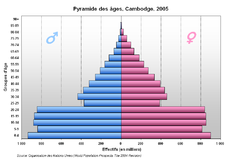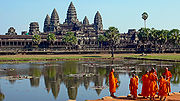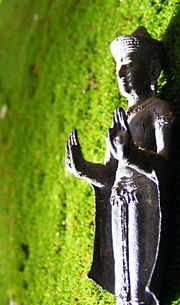- Demographics of Cambodia
-
This article is about the demographic features of the population of Cambodia, including population density, ethnicity, education level, health of the populace, economic status, religious affiliations and other aspects of the population.
Between 1874 and 1921, the total population of Cambodia increased from about 946,000 to 2.4 million. By 1950 it had increased to between 3,710,107 and 4,073,967, and in 1962 it had reached 5.7 million. From the 1960s until 1975, the population of Cambodia increased by about 2.2 % yearly, the lowest increase in Southeast Asia. By 1975 when the Khmer Rouge took power, it was estimated at 7.3 million. Of this total an estimated one to two million reportedly died between 1975 and 1978. In 1981, the PRK gave the official population figure as nearly 6.7 million, although approximately 6.3 million to 6.4 million is probably more accurate. The average annual rate of population growth from 1978 to 1985 was 2.3% (see table 2, Appendix A). In 1959, Life expectancy at birth was 44.2 years for males and 43.3 years for females. By 1970, life expectancy had increased by about 2.5 years since 1945. The greater longevity for females apparently reflected improved health practices during maternity and childbirth.
In 1959, about 45% of the population was under 15 years of age. By 1962, this had increased slightly to 46 %. In 1962, an estimated 52 % of the population was between 15 and 64 years of age, while 2% were older than 65. The percentage of males and females in the three groups was almost the same.
Contents
- 1 Vital statistics
- 2 CIA World Factbook demographic statistics
- 3 References
Vital statistics
Births and deaths [1]
Period Live births per year Deaths per year Natural change per year CBR* CDR* NC* TFR* IMR* 1950-1955 208 000 109 000 99 000 45.4 23.8 21.6 6.29 165.1 1955-1960 232 000 113 000 119 000 45.2 22.1 23.1 6.29 152.0 1960-1965 260 000 118 000 142 000 44.9 20.4 24.5 6.29 139.5 1965-1970 287 000 127 000 160 000 43.9 19.4 24.5 6.22 130.0 1970-1975 280 000 158 000 122 000 39.9 22.5 17.4 5.54 180.9 1975-1980 227 000 272 000 - 45 000 33.4 40.0 -6.6 4.70 263.2 1980-1985 410 000 127 000 283 000 56.9 17.7 39.2 7.00 134.0 1985-1990 407 000 115 000 292 000 46.7 13.2 33.5 6.00 97.9 1990-1995 417 000 121 000 296 000 40.3 11.3 29.0 5.44 90.0 1995-2000 358 000 121 000 237 000 30.3 10.2 20.1 4.32 83.3 2000-2005 323 000 117 000 206 000 25.1 9.1 16.0 3.41 72.9 2005-2010 321 000 113 000 207 000 23.3 8.3 15.0 2.80 62.4 - CBR = crude birth rate (per 1000); CDR = crude death rate (per 1000); NC = natural change (per 1000); IMR = infant mortality rate per 1000 births; TFR = total fertility rate (number of children per woman)
CIA World Factbook demographic statistics
The following demographic statistics are from the CIA World Factbook, unless otherwise indicated.
Population
- 14,701,717
- Note: estimates for this country take into account the effects of excess mortality due to AIDS; this can result in lower life expectancy, higher infant mortality and death rates, lower population growth rates, and changes in the distribution of population by age and sex than would otherwise be expected (2011 est.)
Year Population (July est.) Growth rate (est.) 2011 14,701,717 +1.72% 2010 14,453,680 −0.28% 2009 14,494,293 +1.77% 2008 14,241,640 +1.76% 2007 13,995,904 +0.82% 2006 13,881,427 +1.80% 2005 13,636,398 +0.22% 2004 13,124,764 +3.67% Population growth rate
- 1.698% (2011 est.)
- 1.71% (2010 est.)
- 1.77% (2009 est.)
- 1.75% (2008 est)
Age structure
Year 0–14 years:
(male)0–14 years:
(female)0–14 years:
(% total)15–64 years
(male):15–64 years
(female):15–64 years
(% total):65 years & over
(male):65 years & over
(female):65 years & over
(% total):2011 2,375,155 2,356,305 32.2% 4,523,030 4,893,761 64.1% 208,473 344,993 3.8% 2010 2,388,922 2,336,439 32.6% 4,498,568 4,743,677 63.8% 197,649 329,038 3.6% Sex ratio
- At birth: 1.045 male(s)/female
- Under 15 years: 1.02 male(s)/female
- 15-64 years: 0.95 male(s)/female
- 65 years and over: 0.6 male(s)/female
- Total population: 0.96 male(s)/female (2011 est.)
Life expectancy at birth
- Total population: 62.67 years
- Male: 60.31 years
- Female: 65.13 years (2011 est.)
HIV/AIDS
HIV/AIDS — adult prevalence rate
- 0.5% (2011 est.)
HIV/AIDS — people living with HIV/AIDS
- 63,000 (2009 est.)
- 75,000 (2007 est.)
HIV/AIDS — deaths
- 1,000 (2011 est.)
- 3,100 (2009 est.)
- 6,900 (2007 est.)
Nationality
- Noun: Cambodian(s) or Khmer(s)
- Adjective: Cambodian or Khmer
Urbanization
- Urban population: 24% of total population (2010 est.)
- Rate of urbanization: 4.6% rate of annual change (2005-10 est.)
Ethnic groups
- Khmer 90%, Vietnamese 5%, Chinese 1%, other 4%.[2]
Religions
- Buddhism: 95%, Islam: 1.6%, Christianity: 0.2%, Others: 3.2%
Languages
Other
Note: In recent decades English and Chinese have become the most attracting foreign language in Cambodia with over 70 Chinese schools and 30,000 students and 1,000 teachers.[5] Other languages spoken in Cambodia are minority languages.
Literacy
- Definition: age 15 and over can read and write
- Total population: 73.6%
- Male: 84.7%
- Female: 64.1% (2004 est.)
Education expenditure
- 1.7% of GDP (2004)
Overseas Population
Countries with notable populations of overseas Cambodians are:
 Thailand
Thailand Vietnam
Vietnam United States
United States France
France Malaysia
Malaysia AUS
AUS Canada
Canada New Zealand
New Zealand China
China UK
UK Laos
Laos Singapore
Singapore Hong Kong
Hong Kong
References
 This article incorporates public domain material from the CIA World Factbook document "2008 edition".Categories:
This article incorporates public domain material from the CIA World Factbook document "2008 edition".Categories:- Demographics by country
- Cambodian society
Wikimedia Foundation. 2010.



